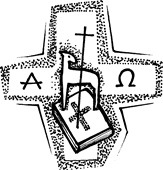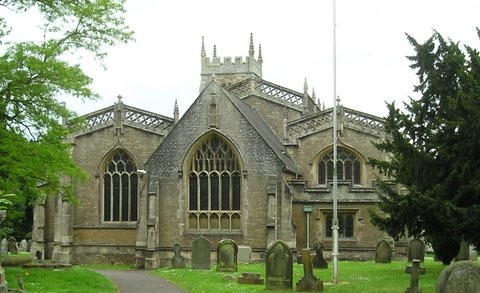Revelation 21;1-6, John 11:32-44
In the name of the living God, father, son and holy spirit Amen
From the earliest times to the present day the church has recognise as part of its foundations – the heroes of our faith the saints whose lives have excited others to holiness and following the Christian way for their lives. Initially this feast All Saints was celebrated on the Sunday after Pentecost, which kind of makes sense – as there is a link between the disciples receiving the holy spirit and the saints living in the power of the spirit. However, this commemoration moved in around the 8th century to its current date – 1st November. A pope dedicated a chapel to All Saints in St Peter’s Rome on 1 November and within a century, this day was observed as All Saints day across Britain and Ireland. Now in the church year – All Saints marks the beginning of the run up to the end of the church year as we ramp up into the time between All Saints and Advent. We explore the themes of remembering and kingdom and Christ as King, before we start again and return to the beginning of the church year on Advent Sunday.
I recently heard a great illustration of the Christian understanding of time which used ribbon. We tend to view time as linear as a progression from one year to the next through our lives. (This is depicted by the the ribbon laid flat and stretched out). But from the perspective of God time is a much wider concept and God’s work is not just restricted to our linear understanding of time and more circular or cyclical. So if we arrange the ribbon with the beginning near the end this makes a better illustration. In the church’s understanding of time as we move through the church year we have times like we are entering now. If the ribbon is arranged in a circle where the end is near the beginning and the beginning is near the end – it is closer to the understanding we need!
Both of our readings today also tune into a more mysterious understanding and one not limited by a linear understanding of time. They tap into the ethereal understanding we need to have our God, which is not just our linear progression through time but one pointing to majesty and kingdom
The first reading is a marvellous bit of scripture from the book of Revelation. Where John is describing what I have always thought of as our eternal destination and final resting place, describing life with God in eternity – what eternal life might be like. It is picture language and needs us to tune in our imaginations. He describes this as a holy city – where God is with his people and his people with God. Where death has passed along with the difficult things of this life. Where mourning, crying and pain will be no more.
 This is quite a common choice as a funeral reading as it gives us hope and reassurance that loved ones who have died are fully with God and loved and cherished and safe. It gives us grounds for hope for ourselves too. John describes the alpha and the omega – the beginning and the end. The alpha and omega are the first and last letters of the greek alphabet – mirroring the beginning and the end statements!
This is quite a common choice as a funeral reading as it gives us hope and reassurance that loved ones who have died are fully with God and loved and cherished and safe. It gives us grounds for hope for ourselves too. John describes the alpha and the omega – the beginning and the end. The alpha and omega are the first and last letters of the greek alphabet – mirroring the beginning and the end statements!
The phrase also mirrors much philosophical thought of Jesus times. In the 1st century as well as an understanding of the temporal a Greek source from 350BC abit before this passage was written – It said Zeus is the beginning, Zeus is the middle, all things are fulfilled by Zeus. Likewise Plato is thought to have said “God … holds the beginning and the middle and the end of all things which exist. Hippocrates, refers to the beginning and end as a kind of unbroken circle “The beginning of everything is one and the end of everything is one and the end and the beginning are the same.” Then the stoic emperor Marcus Aurelius said the soul that “knows the beginning and the end”. The knows in that statements is using the term Logos (which is what we translate as the Word or meaning) that penetrates the universe. Beginning and end, I know who created heaven and earth / for all things are from him, he knows what is from the beginning to the end. All of this was important to Greek society – to establish cosmic sovereignty and lordship for God. It is interesting to reflect on this as our thoughts turn to the sovereignty and lordship of God as we move into this time of endings and the kingdom and Jesus as king in the church year.
Today’s second reading is equally interesting, the time interpretation here is more down to earth as we encounter Martha – practical as always concerned that if they open the tomb of Lazarus the stench will be unbearable. Her brother had been dead for 4 days, but this time is not an obstacle to Jesus who prays to the Father and cries for Lazarus to come out. And indeed Lazarus comes, bound in strips of cloth and his face wrapped in a cloth. I heard a talk by Timothy Radcliffe (Roman catholic Cistercian monk) about the need to unbind Lazarus and let him go, which are the final words of Jesus we heard. Again time is not an obstacle to Jesus work here. In our rational age there is a tendency to ponder on the hows and whys of this story – which will get us nowhere fast and not take a step back and inspiration from the stuff of God being mysterious and other worldly.
In a way and I concur with Timothy Radcliffe over this belief is more difficult in our secular society – God needs to be mysterious – so that we need to make a choice. It cannot be all logic and reason! That stuff is dry and sterile! In 1 Corinthians 13 we remember we see in a mirror darkly but then we shall see face to face – what the Revelation passage was about. I also think that those words of Jesus said as Lazarus is having difficulty moving from the tomb due to his bounding – something that sometimes need to be said to us. Unbind him and let him go
Jesus says this to enable Lazarus to walk free and walk once more in what we describe as the land of the living. I don’t suppose Lazarus got hung up on what happened (the whys and wherefores) but was just thankful! Our God of love is in the transformation business but cannot work in us unless we are willing participants. Open to his guiding and leadership and less hung up on the logical and rational, and the lures of science and reason.
I am going to end these reflections with one of those stories to help us think – there is a real twist in the tale of this one! It is from The Wounded Healer, By Henri Nouwen and retells a tale from ancient India.
Four royal brothers decided each to master a special ability. Time went by, and the brothers met to reveal what they had learned. “I have mastered a science,” said the first, “by which I can take but a bone of some creature and create the flesh that goes with it.” “I,” said the second, “know how to grow that creature’s skin and hair if there is flesh on its bones.” The third said, “I am able to create its limbs if I have the flesh, the skin, and the hair.” “And I,” concluded the fourth, “know how to give life to that creature if its form is complete.”
Thereupon the brothers went into the jungle to find a bone so they could demonstrate their specialties. As fate would have it, the bone they found was a lion’s. One added flesh to the bone, the second grew hide and hair, the third completed it with matching limbs, and the fourth gave the lion life. Shaking its mane, the ferocious beast arose and jumped on his creators. He killed them all and vanished contentedly into the jungle.
We too have the capacity to create what can devour us. Logic and rationality and even inappropriate goals and dreams not of God’s will for us can consume us. Pre-occupation with things and stuff can certainly turn us from God’s path too. Let’s recapture some awe, wonder and the mystery of God this day. We need to seek first God’s kingdom in all that we are and his righteousness for there is the heavenly city of eternal life with God. The alpha and omega – the beginning and the end. Amen
The New Revised Standard Version (Anglicized Edition), copyright 1989, 1995
Henri Nouwen’s – the wounded healer
Greek Philosophy from © ROOTS for Churches Ltd (www.rootsontheweb.com) 2002-2021. Reproduced with permission.


